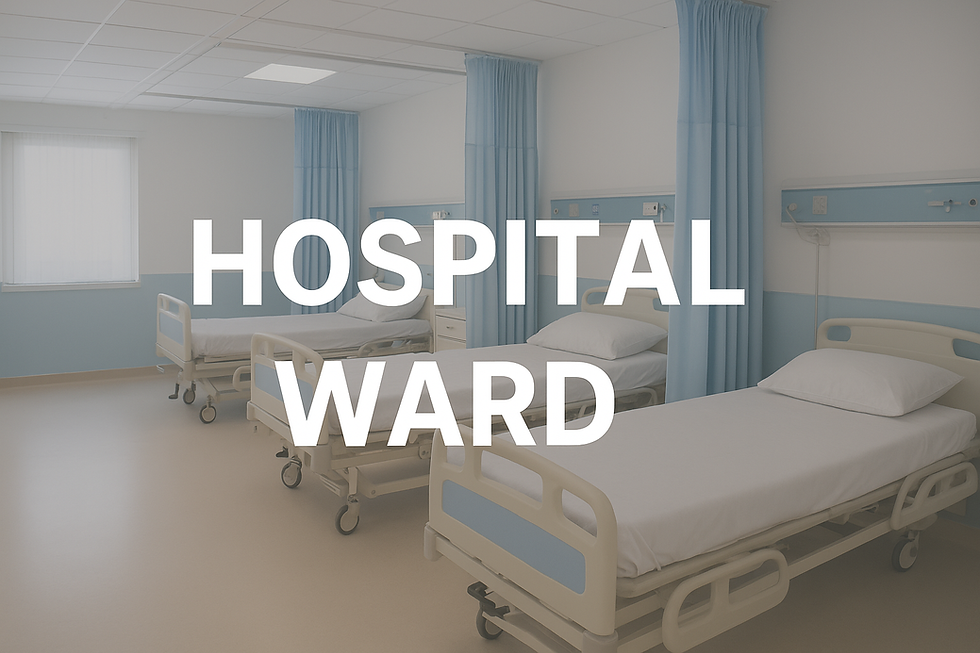Decoding Hospital Beds: Understanding Varieties and Their Roles in Care
- Dhruv Dixit
- Mar 6
- 4 min read
Over the years, advancements in medical technology have transformed traditional beds into highly functional units equipped with multiple adjustment features, mobility mechanisms, and emergency response systems.
These modern hospital beds come with automated adjustments, emergency positioning, and ergonomic designs, all of which contribute to enhanced patient comfort and recovery, improved efficiency, and quick emergency response. With healthcare demands evolving, investing in the right hospital bed is no longer a luxury but a necessity
Increasing demand for such patient-centric healthcare solutions makes understanding the varieties and roles of hospital beds crucial for hospitals, caregivers, and patients. From basic manual beds to highly specialized ICU models, each type serves a distinct purpose, ensuring that patients receive the right level of care tailored to their medical needs.
Varieties of Hospital Beds
Each adjustable hospital bed type is designed with specific patient needs in mind. Understanding these varieties helps in making informed choices for healthcare facilities, home care, and specialized treatment settings.

Operated using hand cranks, these beds allow basic height and position adjustments. They are cost-effective, durable, and ideal for non-critical patients in general wards or home-care environments.

These beds provide a partially inclined backrest, making them suitable for post-surgical recovery, respiratory conditions, and general patient care where slight elevation is required for comfort.

With automated controls, these beds allow seamless adjustments for height, backrest, and leg positions. They are widely used in ICUs, post-surgical recovery, and long-term patient care, ensuring minimal strain on caregivers.
4. ICU Beds

Designed for critical care patients, ICU beds come with advanced features like:
CPR positioning
Trendelenburg and reverse Trendelenburg adjustments
Integrated patient monitoring systems
Smooth mobility for emergency transfers

Specifically designed for children’s safety and comfort, these beds feature protective side rails, adjustable settings, and child-friendly designs to make hospital stays less intimidating for young patients. Check out our blog on: Transforming Pediatric Wards with Specialized Hospital Beds for Kids

These high-mobility beds are crucial for moving patients between hospital departments. Unlike stretchers, transport beds provide stable support, allowing uninterrupted care even during movement.

Designed for heavier patients, these beds have reinforced frames, wider dimensions, and higher weight capacities to ensure safety, support, and comfort.
Role of Hospital Beds in Critical Care
While different types of hospital beds cater to specific needs, their roles in patient care are defined by the functions they offer. Advanced beds are equipped with multiple functionalities, ensuring better patient management, emergency responsiveness, and long-term care solutions.
1. Supporting Critical Care & Emergency Response
Beds with CPR positioning systems allow healthcare providers to initiate life-saving interventions without delays. Traditional beds often require patient transfers before administering CPR, whereas specialized beds ensure patients receive immediate care in emergencies.
2. Ensuring Optimal Posture & Comfort
Beds with multi-functional adjustments help patients find the most comfortable position for pain relief, respiratory ease, or post-surgical recovery. Adjustable height settings also allow safe patient transfers, reducing caregiver strain.
3. Enhancing Mobility & Transport Efficiency
Hospital beds with smooth mobility systems reduce the need for frequent patient transfers. The ability to move a patient without shifting them onto a stretcher significantly lowers the risks of injuries, stress, and delays during treatment.
4. Reducing Caregiver Fatigue
Manually adjusting a patient’s position is physically demanding. Beds with automated adjustments and easy maneuverability improve caregiver efficiency, allowing them to focus more on medical care rather than manual labor. Also read: The Role of Ergonomic Hospital Beds in Reducing Caregiver Fatigue
5. Improving Circulation & Preventing Bedsores
Long-term patients often suffer from bedsores due to prolonged immobility. Advanced beds with pressure-relief surfaces and customizable incline features help in redistributing weight, reducing pressure points, and preventing ulcers.
6. Adapting to Specialized Medical Needs
Some patients require specific postures for treatment—such as those recovering from spinal injuries, undergoing ventilation, or in post-surgical care. Hospital beds with Trendelenburg, reverse Trendelenburg, and lateral tilt functions ensure that medical professionals can optimize treatment without patient discomfort.
7. Minimizing Patient Transfers
Frequent patient transfers increase risks of injuries, discomfort, and medical complications. Modern hospital beds reduce the need for unnecessary movements by offering multi-functional positioning, CPR readiness, and seamless emergency adaptability.
Patient-Centric Hospital Beds Making a Difference
As healthcare continues to evolve, the need for advanced hospital beds has never been more critical. From improving patient comfort to enhancing emergency responsiveness and caregiver efficiency, these beds play a crucial role in modern medical care.
With hospitals and healthcare facilities prioritizing efficiency, safety, and innovation, investing in the right hospital beds is not just a choice, it’s a necessity. As technology advances, hospital beds will continue to evolve, ensuring that both patients and caregivers experience the highest level of support and care possible.
At Aslams, we understand that the right hospital bed isn’t just about comfort, it’s about precision, adaptability, and enhancing patient outcomes. Our carefully curated range spans from single-function beds for basic care to seven-function, fully automated beds designed for ICUs and specialized treatment. From manual beds for cost-effective solutions, to semi-fowler beds for recovery, or high-tech ICU beds with emergency response features, we ensure that every healthcare facility finds the perfect fit. With quality craftsmanship, advanced technology, and a strong commitment to patient care, Aslams continues to be a trusted name in hospital bed solutions in India.




Comments